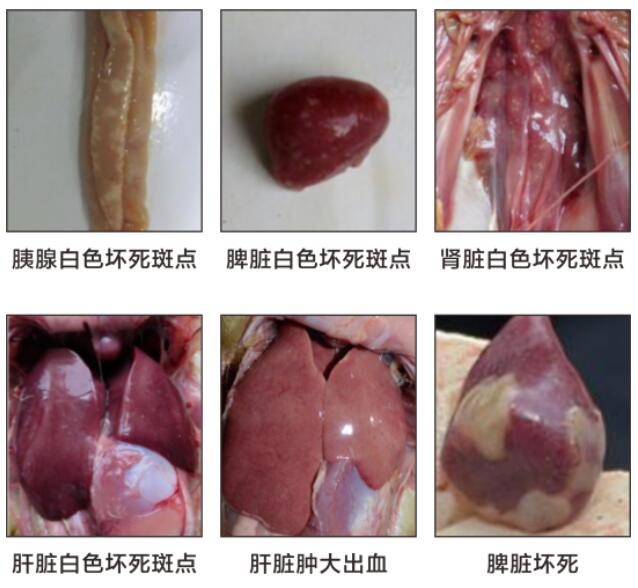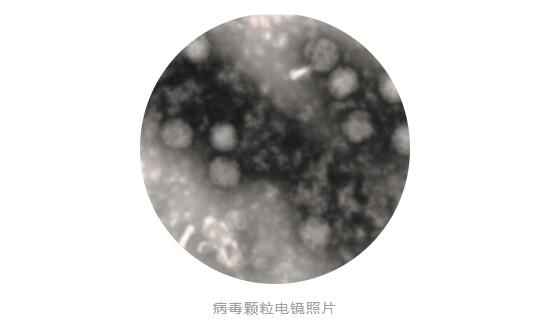
What is avian reovirus?
Avian Reovirus (ARV) is an important pathogen in poultry, belonging to the family Reoviridae and the genus Orthoreovirus. The virus was first isolated from the respiratory tract of chickens suffering from chronic respiratory diseases and can cause infection in a variety of poultry including chickens, ducks, Muscovy ducks, geese, etc. At present, reovirus disease has become one of the common diseases in my country's waterfowl breeding industry.
Reovirus infections in waterfowl in my country are mainly divided into 4 types:
NO.1
A new Muscovy Duck Reovirus (Novel Duck Reovirus, NDRV), also known as duck spleen necrosis, is a disease characterized by irregular necrosis and bleeding of the liver and spleen.
NO.2
Muscovy duck liver disease, also known as Muscovy duck liver white spot disease, is caused by Muscovy duck reovirus (MDRV). The diseased duck liver, spleen, pancreas, intestine and other tissues and organs have a large number of white necrotic spots on the surface.
NO.3
Goose hemorrhagic necrotizing hepatitis, a new type of goose reovirus (GRV), causes diffuse hemorrhagic spots of varying sizes and light yellow or gray-yellow necrosis spots on the surface of the liver of affected geese. Histopathology is characterized by diffuse Hemorrhagic necrotizing hepatitis is the main feature.
NO.4
Duck Reovirus (DRV) can cause spleen necrosis in Peking ducks. The main disease of the Peking duck that died was the liver. The color of the liver turned light and khaki, and the liver showed spot-like and patchy irregular bleeding, and sometimes yellow-white necrosis foci appeared. The spleen was enlarged and necrotic, showing needle-point white dots or irregular patchy necrosis foci, which was severe. Presenting jujube pit-like necrotic lesions.

Virus characteristics
New duck reovirus (NDRV), Muscovy duck reovirus (MDRV) and the earlier discovered avian reovirus (ARV) all belong to the family Reoviridae and the genus Orthoreovirus. Under an electron microscope, NDRV has the morphological structure of a typical reovirus. The virus particles are spherical, non-enveloped, have a double-layered capsid, and have an icosahedral symmetry structure. The diameter of the virus particles is approximately 60-85 nm. MDRV is a double-stranded RNA virus with a double capsid but no envelope. The inner capsid has a stable structure. The diameter of the virus particle is about 50-75nm, and its shape is a spherical shape with icosahedral symmetry.

Epidemic characteristics and clinical symptoms
Muscovy duck reovirus
Muscovy duck reovirus (MDRV) generally infects Muscovy ducks and semi-Muscovy ducks, but has no obvious pathogenicity for shelducks, Cherry Valley ducks and chickens. Muscovy ducklings aged 7 to 35 days are most susceptible to the disease, and Muscovy ducklings aged 10 to 25 days are most susceptible to the disease. And the younger the age, the higher the morbidity and mortality. The morbidity is between 20% and 60%, sometimes up to 90%, and the mortality is between 10% and 60%. The disease has no obvious seasonality and can occur throughout the year. However, the incidence rate of the disease is higher when stimulated by adverse stress conditions such as hot weather, humid environment, dirty sanitation facilities, etc., and the duration of the disease varies.
The main clinical symptoms of Muscovy duck reovirus (MDRV) infection include soft feet, diarrhea, depression, etc. Some infected ducks have varying degrees of swelling in the toe joints or tarsal joints, and the growth and development of ducks that have not tolerated the disease are hindered.
Novel duck reovirus
The new duck reovirus (NDRV) has no obvious seasonality and can occur in both the north and the south. All duck species can be infected, such as shelducks, cherry valley ducks, muscovy ducks, semi-muscovy ducks, etc. The age of onset is 4 to 26 days, and the duration of the disease is variable. The incidence rate ranges from 5% to 80%, and the mortality rate of infected ducks is between 5% and 50%. The younger the age, the higher the mortality rate. It can be transmitted vertically and horizontally. NDRV nucleic acid testing was performed on Muscovy ducks at the main onset age (3 to 15 days old). The highest detection rate was in the spleen, which could reach 100%, followed by the liver, heart and bursa of Fabricius. Therefore, the liver and spleen can be used as the first choice organs for virus detection and isolation.
Ducks infected with the new duck reovirus (NDRV) mainly show symptoms such as listlessness, loss of appetite, rough coat, diarrhea and weight loss, but they do not have soft feet. Some ducks will develop neurological symptoms such as opisthotonus. According to Different liver and spleen lesions are often called "duck new liver disease", "duck hemorrhagic necrotizing hepatitis", "duck spleen necrosis", etc. in clinical practice.
Pathological changes
Muscovy duck reovirus (MDRV) mainly causes liver and spleen enlargement, with a large number of white necrotic spots covering the surface. Yellow-white stripes may also appear on the kidney surface, but gray-white spots on the liver surface are the most typical. Fibrinous pericarditis and peripheral hepatitis can also be observed in the late stages of infection, commonly known as "liver white spot disease" or "spotted liver" in Muscovy ducks.
The main pathological changes of the new duck reovirus (NDRV) at necropsy are hepatosplenomegaly, brittle liver, varying degrees of patchy/punctate hemorrhage and necrosis on the surface, and organs such as heart, kidney and bursa of Fabricius can be seen in some ducks. Swelling and bleeding points, etc.
Prevention
NO.1
Strengthen feeding management, establish a strict sanitation and disinfection system, and improve epidemic prevention awareness. It is recommended that duck farms use self-breeding and self-raising methods for breeding. If ducks must be introduced, they must be purchased from regular channels. It is best to adopt an all-in, all-out system for duck houses and raise them in groups according to age.
NO.2
The disease can be prevented with a vaccine. Breeding ducks are immunized with attenuated vaccine for the first time one month before giving birth, and boosted once 2 weeks later. Each intramuscular injection of 1 ml can provide maternal antibodies to offspring ducklings, but maternal antibodies are not enough to completely protect the offspring. It is recommended that ducklings be injected with corresponding yolk antibodies when they are 1-3 days old, which can have a good preventive effect.
NO.3
Once the disease occurs in ducklings, the corresponding yolk antibody should be quickly injected with a dosage of 1-2ml/bird (the dosage is adjusted according to the age of onset), which can quickly and effectively reduce mortality and prevent the spread of the pathogen.